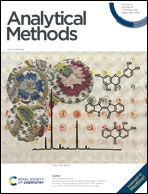A bio-compatible pyridine–pyrazole hydrazide based compartmental receptor for Al3+ sensing and its application in cell imaging†
Abstract
For practical applications, the development of bio-compatible organic molecules as p-block ion chemosensors is critical. Herein, we report the single crystal (SC) of new pyridine–pyrazole derived Al3+ sensor H2PPC [(Z)-N'-(2,3-dihydroxybenzylidene)-5-methyl-1-(pyridin-2-yl)-1H-pyrazole-3-carbohydrazide] as well as its Cu-complex SC. The probe exhibits an “off–on” fluorescence response towards Al3+ ions, and this has been modulated with different solvents. For selective detection of Al3+ ions, a special coordination pocket in the structural backbone is advantageous. The chemosensor exhibits a submicromolar detection level (LOD = 4.78 μM) for Al3+. The density functional theory (DFT) and time-dependent DFT (TD-DFT) calculations of H2PPC and [Al(HPP)2]+ (1) reveal that a change of the structural conformation of probe H2PPC upon complexation causes the pyrazole and pyridine units to create a specific cavity to tether Al3+, and consequently H2PPC proves to be a promising molecule for Al3+ detection. Furthermore, the probe has been successfully used to evaluate Al3+ as a low-cost kit using filter paper strips, and the in situ Al3+ ion imaging in Vero cells as well as A549 cell lines shows the sensor's nuclear envelope penetrability, indicating that it has great potential for biological and environmental applications.



 Please wait while we load your content...
Please wait while we load your content...